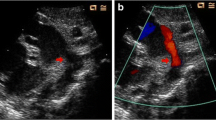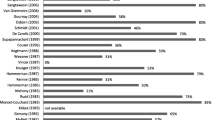Abstract
Purpose
To identify risk factors related to the failure of indomethacin therapy and the need for surgical repair in patent ductus arteriosus (PDA) in extremely low-birth-weight (<1000 g) infants (ELBWI).
Methods
Study subjects were 36 ELBWI with PDA born at a single tertiary perinatal center. They were classified into those who required surgery due to failure of indomethacin treatment (surgical group, n = 21) and those with effective indomethacin treatment (non-surgical group, n = 15). The odds ratios (ORs) and 95% confidence intervals (95% CIs) for the relationship between selected risk factors and surgical treatment of PDA were calculated.
Results
Gestational age of <28 weeks and diameter of PDA of 2 mm or more were independent and significant determinants of the need for surgical repair of PDA (adjusted ORs [95% CIs] = 9.91 [1.16–84.48] and 24.80 [2.72–225.74], respectively). The need for surgical repair of PDA did not correlate with sex, birth weight, 1-min Apgar score, left atrium diameter/aortic diameter (LA/Ao), left ventricular internal dimension at end-diastole, prophylaxes with indomethacin, and total dosage of indomethacin.
Conclusions
Gestational age at birth of <28 weeks and diameter of PDA of 2 mm or more are determinants of failure of indomethacin treatment for PDA and the need for surgical repair.

Similar content being viewed by others
References
Hammerman C, Kaplan M. Comparative tolerability of pharmacological treatments for patent ductus arteriosus. Drug Saf. 2001;24:537–51.
Kitterman JA, Edmunds LH Jr, Gregory GA, et al. Patent ductus arteriosus in premature infants. Incidence, relation to pulmonary disease and management. N Engl J Med. 1972;287:473–7.
Ichihashi K, Shiraishi H, Endou H, et al. Cerebral and abdominal arterial hemodynamics in preterm infants with patent ductus arteriosus. Acta Paediatr Jpn. 1990;32:349–56.
Heymann MA, Rudolph AM, Silverman NH. Closure of the ductus arteriosus in premature infants by inhibition of prostaglandin synthesis. N Engl J Med. 1976;295:530–3.
Amin SB, Handley C, Carter-Pokras O. Indomethacin use for the management of patent ductus arteriosis in preterms: a web-based survey of practice attitudes among neonatal fellowship program directors in the United States. Pediatr Cardiol. 2007;28:193–200.
Little DC, Pratt TC, Blalock SE, et al. Patent ductus arteriosus in micropreemies and full-term infants: the relative merits of surgical ligation versus indomethacin treatment. J Pediatr Surg. 2003;38:492–6.
Shaffer CL, Gal P, Ransom JL, et al. Effect of age and birth weight on indomethacin pharmacodynamics in neonates treated for patent ductus arteriosus. Crit Care Med. 2002;30:343–8.
Alexander F, Chiu L, Kroh M, et al. Analysis of outcome in 298 extremely low-birth-weight infants with patent ductus arteriosus. J Pediatr Surg. 2009;44:112–7. disscusion 117.
Narayanan M, Cooper B, Weiss H, Clyman RI. Prophylactic indomethacin: factors determining permanent ductus arteriosus closure. J Pediatr. 2000;136:330–7.
Schwartz MZ, Palder SB, Tyson KR, et al. Complications of prematurity that may require surgical intervention. Arch Surg. 1988;123:1135–8.
Hermes-DeSantis ER, Clyman RI. Patent ductus arteriosus: pathophysiology and management. J Perinatol. 2006;26:S14–8. discussion S22–S23.
Boo NY, Mohd-Amin I, Bilkis AA, et al. Predictors of failed closure of patent ductus arteriosus with indomethacin. Singapore Med J. 2006;47:763–8.
Ekici F, Atasay B, Gunlemez A, et al. Management of patent ductus arteriosus in preterm infants. Anadolu Kardiyol Derg. 2006;6:28–33.
Lin CT, Liu WH, Cheng BC, et al. Surgical closure of patent ductus arteriosus in preterm infants at neonatal intensive care unit. Acta Paediatr Taiwan. 2003;44:287–91.
Author information
Authors and Affiliations
Corresponding author
About this article
Cite this article
Yoshikane, Y., Mori, T., Yoshizato, T. et al. Determinants of surgical repair of patent ductus arteriosus in low-birth-weight infants. J Med Ultrasonics 38, 151–155 (2011). https://doi.org/10.1007/s10396-011-0309-8
Received:
Accepted:
Published:
Issue Date:
DOI: https://doi.org/10.1007/s10396-011-0309-8




